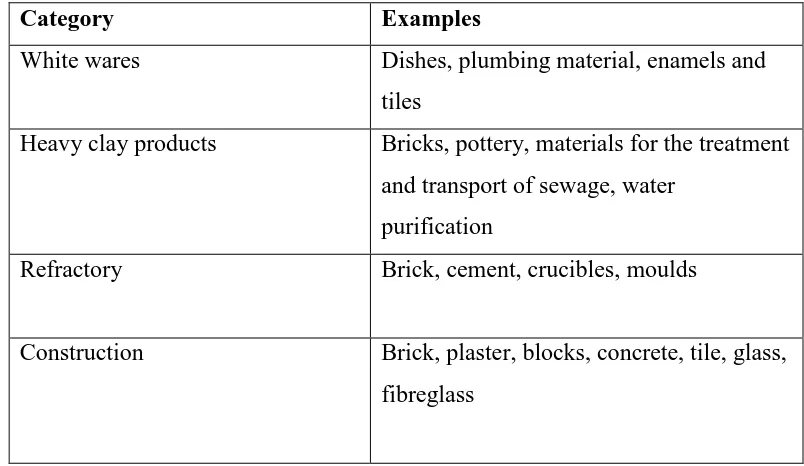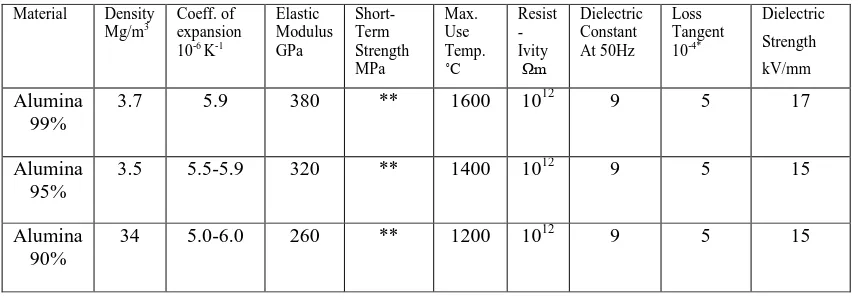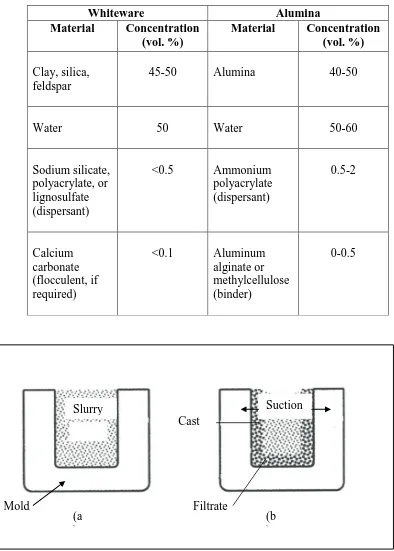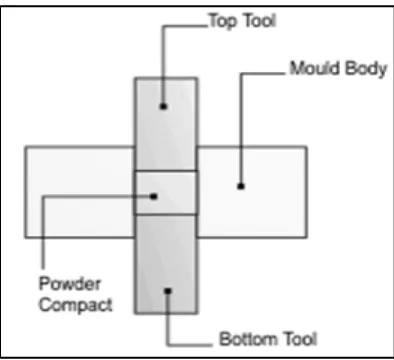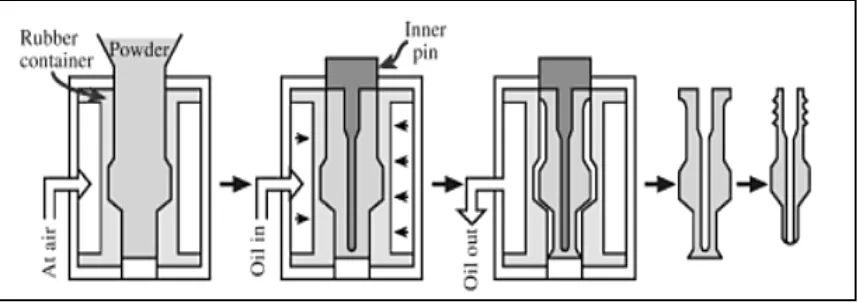FABRICATION OF ALUMINA CRUCIBLE
RINI BINTI RUSLAM
UNIVERSITI TEKNIKAL MALAYSIA MELAKA
FABRICATION OF ALUMINA CRUCIBLE
This report submitted in accordance with requirement of the Universiti Teknikal Malaysia Melaka (UTeM) for the Bachelor Degree of Manufacturing Engineering
(Engineering Material) with honours.
By
RINI BINTI RUSLAM
ABSTRACT
Ceramic crucibles is fabricate from alumina material by using slip casting process. Two
different batches are produced by the different amount of talc as the additive in each
batch in order to determine the effect of talc to the alumina products that produced. The
volume of talc that is used in batch B is higher compare to the volume that is used in
batch A. The effect of the casting time to the crucible thickness was investigated by using
various casting time. From the experimental that has done showing that, the longer
casting produce higher crucible thickness. The shrinkage level of both batches was
measured for drying process, bisques process and sintering process. The result was
showing that, the shrinkage level is majorly happen during the sintering process. The
mechanical properties of each batches is studied through flexural test and microstructure
observation using SEM. The specimens that produced from batch B is defining have
batter mechanical properties compare to specimens from batch A. The specimens are
ABSTRAK
Mangkuk pijar seramik dihasilkan daripada bahan alumina dengan menggunakan process
pengacuan tuangan. Dua bancuhan yang berbeza dihasilkan dengan membezakan nilai
bedak yang digunakan sebagai bahan tambahan bagi mengenal pasti kesan penggunaan
talc pada produk alumina yang dihasilkan. Bancuhan B memiliki kandungan bedak yang
lebih tinggi daripada bancuhan A. Kesan masa pengacuanan dikaji dengan menggunakan
masa pengacuan yang berbeza. Proses pengecutan yang berlaku terhadap spesimen
diukur bagi proses pengeringan, proses pra- pemanasan , dan proses pemanasan
melampau di bawah takat lebur. Sifat mekanikal bagi spesimen untuk setiap bancuhan di
kaji dengan menjalankan ujian kekuatan menahan patah, ujian ketumpatan, dan juga
menjalankan pemerhatian terhadap microstruktur bagi spesimen untuk setiap bancuhan
dengan menggunakan mikroskop imbasan electron. Daripada ujikaji yang dijalankan
specimen daripada bancuhan B mempunyai sifat mekanikal yang lebih baik daripada
bancuhan A. Kesemua spesimen dibuktikan dibuat daripada bahan alumina dengan
LIST OF CONTENTS
Abstract………..……….i-ii
Dedication………....iii
List of Contents……… v
List of Tables………..viii
List of Figures ……….ix
List of Abbreviation……….………...xi
1. INTRODUCTION 1.1 Overview of the project 1
1.2 Objective of the project 1
1.3 Scope of the project 2
2.0LITERATURE REVIEW 2.1 Classification of ceramic 3
2.2 Traditional Ceramic 4
2.3 Advance Ceramic 5
2.4 Alumina Ceramic 6
2.5 Ceramic Forming Process 7
2.5.1 Slip Casting Process 7
2.5.2 Press Process 10
2.6 Ceramic Sintering 13
3.0 MATERIAL AND METHODOLOGY 3.1 Starting Material. 17
3.1.1 Alumina Powder 17
3.1.2 Talc Powder 18
3.1.3 BallClay 18
3.1.4 Defloculent 18
3.2 Machine and Equipment 19
3.3 Body Formulation 20
3.4 Methodology of Project 20
3.5 Casting of Ceramic 25
3.6.1 Shrinkage Analysis 27
3.6.2 Density Test 28
3.6.3 Flexural Test 29
3.6.4 SEM Observation 29
4.0 RESULT AND DISCUSSION 4.1 Effect of Casting Time to the Green Body 30
4.2 Measurement of Shrinkage Level 34
4.2.1 Drying Shrinkage 34
4.2.2 Comparison of Shrinkage Level 37
4.3 Flexural Strength 40
4.4 Microstructure Observation .43
4.5 XRD Analysis 47
5.0 CONCLUSION AND RECOMMENDATION 5.1 Conclusion 48
5.2 Recommendation 49
LIST OF TABLES
2.1 Application of Traditional Ceramic 4
2.2 Properties of alumina-based ceramics 6
2.3 Example of Slip-Casting Composition 8
3.1 Ingredient of the Slip 21
4.1 Measurement of Crucible Thickness 33
4.2 Measurement of Shrinkage Reference Line 34
4.3 Percentage of Drying Shrinkage 35
4.4 Measurement of Shrinkage Reference Line 37
4.5 Percentage of Shrinkage 38
LIST OF FIGURES
2.1 Schematic diagram of the slip-casting system 9
2.2 Schematic of the Uniaxial Die pressing process for ceramic powders 11
2.3 Schematic of Isostatic Pressure 11
2.4 Schematic indication of the distinction between densifying and Non-densifying microstructure. 14
2.5 The surface of an alumina ceramic from which all porosity has been removed 15
3.1 The Average of Alumina Particle Size. 17
3.2 Talc Powder 18
3.3 Roller Milling Machine and Alumina Milling Pot 19
3.4 Flow Chart Process of Slip Casting 20
3.5 Ball Media in the Alumina Pot 22
3.6 Profile for Biscuits Process 23
3.7 Profile of Sintering Process 24
3.8 Flow Chart of Crucible Fabrication Process. 25
3.9 The Slip is remaining in the Mould 26
3.10 The Crucible Thickness is measured after the Sintering Process 26
3.11 Illustration of Shrinkage Measurement Line on the Bar Specimen 27
3.12 Illustration of Flexural Test 28
4.1 Crucibles of Batch A with 5 minutes and 15 minutes Casting Time 30
4.2 Crucibles of Batch A with 5 minutes and 15 minutes casting time 31
from top view. 4.3 Crucibles of Batch B with 5 minutes and 15 minutes Casting Time 31
4.4 Crucibles of Batch B with 5 minutes and 15 minutes casting time 32
4.6 Measurement of Reference Shrinkage Line (mm) 35
4.7 Percentage of Drying Shrinkage for Composition A and B 36
4.8 Percentage of Shrinkage during Drying, Biscuits and Sintering Process 38
4.9 Comparison of Flexural Strength between Batch A and Batch B 40
4.10 Microstructure for Batch A; 99.8% Al2O3, 0.1 %Talc, 0.1% Ball Clay 41
4.11 Microstructure for Batch B; 90.4 % Al203, 0.5 %Talc, 0.1% Ball Clay 42
4.12 Phase in Alumina Powder 43
4.13 Phase in Ball Clay 44
4.14 Phase in Talc Powder 45
4.15 Phase in Batch A 46
LIST OF ABBREVIATIONS, SYMBOLS, SPECIALIZED NOMENCLATURE
Al2O3 - Alumina
MgO - Magnesium Oxide
NH4+ - Ammonia
NH4+-PMA - Salt of poly(meth acrylic acid)
SiC - Silicon carbides Si3N4 - Silicon nitride
CaSO4.2H2O - Gypsum
˚C - Degree Celsius
% - Percent
Wt% - Weight percent
h - Hour
m - Meter
MPa - Mega Paschal
µm - Micrometer
ζ - Zeta
SEM - Scanning electron microscopy
CHAPTER 1
INTRODUCTION
1.1 Overview of Project.
A detail understanding in fabrication of ceramic product i.e. alumina crucibles through slip casting process will be achieved from the research work. Two types of casting, which are drain casting and solid casting are investigated. Talc powder was added into alumina based material. Microstructure phase analysis, flexural properties, and shrinkage properties are studied.
1.2 Objective of the project:
The objectives of this project are listed as below:
To study the effect of casting time to the crucible thickness.
To investigate the shrinkage level of the ceramic. To examine the effect of talc addition into alumina.
1.3 Scope of the project:
The scopes of the project are presented as below: Preparation of slip at two different compositions:
oBatch B: 99% Al2O3, 0.1% Ball Clay, 0.5% Talc
Fabricate the crucible with various casting time : o 5 minutes casting time
o 15 minutes casting time
Measure the shrinkage percentage for both batches.
CHAPTER 2
LITERATURE REVIEW
2.1 Introduction.
2.2 Traditional Ceramics
[image:16.612.126.528.233.466.2]Traditional ceramics was named for the ceramic that made from naturally occurring material such as clay minerals. Traditional ceramics application includes; white ware, heavy clay products, refractory, construction materials, abrasive products and glass. (Anonymous1, 2008)The example of traditional ceramics application is summarized in Table 2.1 below.
Table 2.1: Application of Traditional Ceramics (Anonymous 1, 2008) Category Examples
White wares Dishes, plumbing material, enamels and tiles
Heavy clay products Bricks, pottery, materials for the treatment and transport of sewage, water
purification
Refractory Brick, cement, crucibles, moulds
Construction Brick, plaster, blocks, concrete, tile, glass, fibreglass
Based to (Anonymous1, 2008) clay minerals are produced from hydrated compounds of aluminium oxide and silica. Clay mineral has layered structures including Kaolinite, hallo site, pyrophillite and montmorillonite. These elements are all formed by the weathering of igneous rocks under the influence of water, dissolved CO2, and organic acid. Anonymous 1 stated that, the main sources of clay minerals were formed when feldspar was eroded from granite and deposited in lake beds, where it becomes altered to clay.
ceramic production include talc, asbestos, wollastonite and sillimanite. (Anonymous1, 2008)
2.3 Advance Ceramics
According to (Geiger, 2001) advance ceramic is the ceramic materials that have the exhibit superior mechanical properties, corrosion or oxidation resistance as well as thermal, electrical, optical or magnetic properties. Advance ceramic were define more pure and offered more control over the composition, microstructure, and crystal structure over minerals-based ceramics compared to traditional ceramic.
The advance ceramic is also termed as engineering and technical ceramics. (Geiger, 2001) also stated that, advance ceramic are generally divided into several classes including structural ceramics, electrical and electronic ceramics, ceramic coating and the last but not least the chemical processing and environmental ceramic.
Based to the same reference, the structural ceramic is defined including the application such as industrial wear parts, cutting tools, engine component and also the bio ceramics. For the electronic application, advance ceramic has a bigger share, including capacitors, substrates, integrated circuit packages, piezoelectric, magnets and also superconductors. Meanwhile, ceramic coating application is also found in engine components, cutting tools, and industrial wear parts. (Geiger, 2001)
2.4 Alumina Ceramics.
Alumina (Al2O3) is one examples of advance ceramic. This material is one of the extensively utilized structural ceramics. This material is having great potential to be used in many spherical application that required low density, high hardness chemical inertness and good high temperature. Material based on alumina (Al2O3)
used in the ceramic production is based to the final characteristic of the product that wants to produce. (Bolton, 1998)
[image:18.612.121.550.290.440.2]Generally, the content of alumina that used in ceramic production is between 100% and 80%. For the example, ceramic with more than 99.7% of alumina is used for refractory purposes. Meanwhile, ceramic with 96.5% to 99.0% of Alumina content, with addition of magnesium oxide is the ideal composition for producing electrical and engineering component. Table 2.2 below shows the properties of alumina-based ceramics. (Bolton, 1998)
Table 2.2: Properties of alumina-based ceramics. (Bolton, 1998)
2.5 Ceramics Forming Processing
The very specific characteristic of ceramic which have high temperature stability, makes conventional fabrication routes being unsuitable for ceramic processing. Ceramic processing can be classified into traditional ceramic forming and non -traditional ceramic forming.
2.5.1 Slip Casting
Slip casting which is also known as drain casting is the most common ceramic casting process. A slip is a suspension of colloidal ceramics particles in an immiscible liquid (generally water) which is insoluble in each other. (Kalpakjian, 2008) Ceramic shaping process, such as slip casting requires the dispersion of ceramic powder in an aqueous solution. (Hotta et.al, 2003) In general, ceramic
Material Density Mg/m3
Coeff. of expansion 10-6 K-1
Elastic Modulus GPa Short- Term Strength MPa Max. Use Temp. ˚C Resist - Ivity Ωm Dielectric Constant At 50Hz Loss Tangent 10-4* Dielectric Strength kV/mm Alumina 99%
3.7 5.9 380 ** 1600 1012 9 5 17 Alumina
95%
3.5 5.5-5.9 320 ** 1400 1012 9 5 15 Alumina
90%
slurries must satisfy the following conditions to produce dense green bodies which including ; low viscosity, high solid content, and good dispersion. Good ceramic slurry is achieved by strong electrostatic, steric repulsion and weak attractive inter-particle van der Waals forces. (Kamiya and Yoshida, 2001)
According to (Rahman, 2007), the free flowing slurry of slip casting is poured into a permeable mold which commonly made from gypsum (CaSO4.2H2O). The micro porous nature of the mold provides a capillary suction pressure, on the order of ~0.1 to 0.2 MPa, which draws the liquid from the slurry into the mold which known as filtrate. A consolidated layer of solid is forms on the walls of the mold. Figure 2.1, showing the forming of solid layer on the walls of the mold during the slip casting process .After the sufficient thickness of the cast has formed, the surplus slip is poured out and the cast are allowed to dry. This drying time will depend on the wetness of the mold and the thickness of the casting. (Burkett, 1993)
Normally the cast shrinks away from the mold during drying and can easily be removed. Once fully dried, the cast is heated to burn out any organic additives and then sintered to produce the final article. (Rahman, 2007) The examples of slip-casting composition are present in Table 2.3.
Table 2.3: Example of Slip-Casting Composition (Rahman, 2007)
[image:20.612.139.533.96.647.2]
Figure2.1: Schematic diagram of the slip-casting system: (a) initial system (b) after the formation of the thin cast.
White ware Whiteware Alumina Material Concentration
(vol. %)
Material Concentration (vol. %)
Clay, silica, feldspar
45-50 Alumina 40-50
Water 50 Water 50-60
Sodium silicate, polyacrylate, or lignosulfate (dispersant)
<0.5 Ammonium polyacrylate (dispersant) 0.5-2 Calcium carbonate (flocculent, if required)
In slip casting process, the slip should be poured slowly and smoothly into the cavity of the mould along the edge to remove all air from the cavity and prevent at the same time the formation of air pockets or bubbles in the clay. During pouring, the stream of slip should be moved around the mould, if the slip strikes only in one place it will cause the cast to pack at that place. This will result in warping of the casting. (Anonymous 2, 2008)
Excess slip need to be drained slowly and evenly from the mould after cast has formed to the proper thickness. If the slip is drained quickly, the suction of the outgoing slip may pull the soft clay away from contact with the plaster wall in the cavity, resulting in a warped casting. (Anonymous 2, 2008)
A small amount of slip is permitted to overflow on the shoulders of the mould when first pouring slip in the cavity. This is done, so that the cast will be held in the cavity, and will not drop out when the mould is first turned upside down. This overflowing permits an even trimming of the top of the casting and insures that the top will be exactly level. This overflowing on the shoulders of the mould is done only with flood moulds, and does not apply to two piece or multi-piece moulds. (Anonymous 2, 2008)
2.5.2 Press Process
Pressing process is one example of non traditional ceramic process. The pressing process can be divided to dry and semidry pressing. For dry powder, the water that typically contain in the powder is less then 2% water .Meanwhile, for semidry powder is containing 5 to 20 % of water. Dry powder is typically use for uniaxial and isostatic pressing process. (Rahman, 2007)
[image:22.612.223.420.339.519.2]Uniaxial pressing is as shown in figure 2.2, is one of the pressing processes that widely used operation in ceramic industry. For uniaxial pressing, the ceramic powder is compacted in a metal die by pressure is applied in a single direction. The formed piece takes on the configuration of die and platens through which the pressure is applied. (William D., 2003)
Figure 2.2: Schematic of the Uniaxial Die pressing process for ceramic powders
Figure 2.3: Schematic of Isostatic Pressure
In preparing the raw material for pressing process, one of the important things is by controlling the flow behaviour of feed material in order to achieved efficient die filling, fast pressing rates and reproducible green body. Based to Rahman, fine powder do not flow very well and are difficult to compact homogeneously, so that spray dried is typically applied to the slurry to granulate them(Rahman, 2007) So that, the initial step of the pressing process is beginning with forming of the slurry as the preparation for the slip casting. In preparing the slip the powder reduction of the grain size is also achieved by applying the mixing and grinding process. For the example is the ball milling process. (Mori et. al., 2004) In their research they have investigate the ball mill simulation in wet mill process as the preparation of the pressing process.
In comparing the effectiveness of isostatic pressing and slip casting as the parior to Cold Isostatic Pressing (Mouzone et, al., 2008) have overcome with a research. As the result, they were defined that, slip casting is able to produce more homogeneous in term of translucency and microstructure through out the sample body compare to isostatic pressing. Therefore, slip casting as a first consolidation
The size of the granules is also important to be concern in order to achieving high density of green body. As was investigate by (Ching and Shun, 2008) they were defined that finer granules size can improve the density of the green body and also reducing the pressure time that needed for cold isostatic pressing.
2.6 Ceramic Sintering
Sintering process is the process where the green body is heated to produce the desired microstructure. The changes occurring during the stage may be fairly complex, depending on the complexity of the staring material. Two terms will be encountered for the heating stage including firing and sintering. Generally the term of firing is often used when the processes occurring during the heating stage are fairly complex, as in production of traditional ceramics. In less complex cases, the term sintering is often used. The simplest case is that for a pure single-phase material (e.g., Al2O3).( Rahman ,2007)
The system is heated to a temperature that is in the range of 0.5 to 0.75 of the melting temperature. (For Al2O3 with the melting temperature of 2073˚C, the
sintering temperature is commonly 1400˚C to 1650˚C.) The powder does not
melt; instead, the joining together of the particles and the reduction in the porosity or in other word can say as the densificationof the body, as required in the fabrication process, which occurs by atomic diffusion in the solid state. This type of sintering is usually referred to as solid-state sintering. Whereas solid-state sintering is the simplest case of sintering, the processes occurring and their interaction can be fairly complex.( Rahman,2007)
